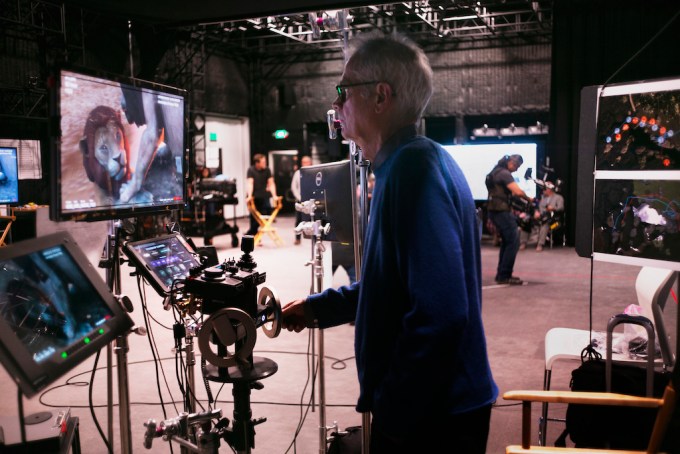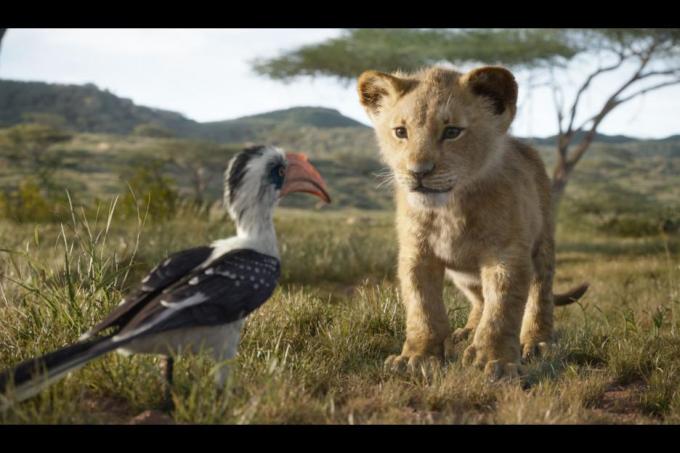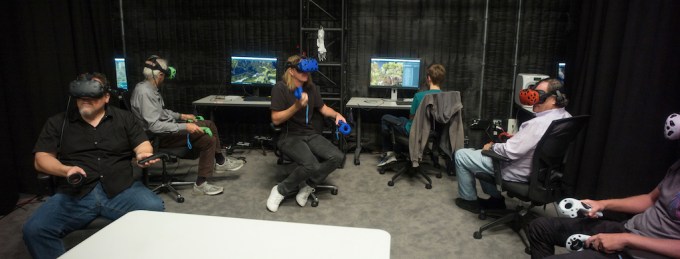When I was told that I’d be visiting the production of Disney’s new “Lion King,” I had a hazy idea of what to expect — sets recreating the iconic landscapes of the animated film, maybe some actors in costumes or motion capture suits.
Instead, if you’ve seen the movie (which came out on July 19), you probably won’t be surprised to hear that there wasn’t a single set or costume in sight. After all, even though the film looks like a live action remake of “The Lion King,” every shot except for the first was created on a computer.
So what I visited in 2017 was a nondescript Los Angeles warehouse filled with computers. In the main room, almost everything was black — black padding on the walls, black VR headsets, black dolly tracks for the camera.
Director Jon Favreau explained to visiting journalists that the plan was to create a virtual Serengeti in the Unity game engine, then apply live action filmmaking techniques to create the film — the “Lion King” team described this as a “virtual production process.”
It started with a research trip to Kenya, with copious reference photos taken of the landscape and animals. Then the art department got to work creating sets — the aforementioned virtual Serengeti — which could be “filmed” by moving a real camera around the space (hence the need for real-world camera equipment like dolly tracks). Those shots are then edited together and handed over to the effects team at MPC to create the images you see in the final film.

THE LION KING – (Pictured) Caleb Deschanel. Photo by: Michael Legato.
© Disney Enterprises, Inc. All Rights Reserved.
“If you go back to ‘Avatar,’ ‘Avatar’ solved the problem of how do you film a movie that usually gets created with computer graphics, so we put computer graphics into the cinematographer’s monitor so that they could use more traditional equipment to see the movie” said virtual production supervisor Ben Grossman. “Fast forward to ‘Lion King’ and what we’re doing is we’re putting the filmmakers inside the monitor. So now, they can put on a VR headset and be in Africa or on the Empire State Building or on the surface of the Moon, so that they can walk around and see and feel the filmmaking process … as though they were there.”
That doesn’t just involve VR and computer animation, Grossman added. There’s also significant use of artificial intelligence in the virtual sets and characters. For example, the filmmakers could create a 3D model of a lion, and then teach the AI so that the lion can act hungry, or cold, or as if it’s looking for food: “We start telling the computer things like that and then it starts to associate behaviors with motivations and intents.”
Ultimately, Grossman suggested that this could lead to a situation where filmmaking is less about traditional “filmmaking or storytelling,” and more about “world-building”: “You create a world where characters have personalities and they have motivations to do different things and then essentially, you can throw them all out there like a simulation and then you can put real people in there and see what happens.”
And while the technology side sounds quite sophisticated, everyone emphasized that the goal was to give the filmmakers the tools they needed to feel like they were making a live action film.

In fact, director of photography Caleb Deschanel (whose career has been focused on live action, with credits like “The Passion of the Christ” and “The Right Stuff”) described himself as “the Luddite in this group,” whose goal was to “try to make it feel as film-y as possible.”
“I remember reading about Brad Bird … who had directed a lot of animation, obviously, and then when he was directing live action, he got very frustrated ’cause he couldn’t do all these sort of crazy things,” Deschanel said. “And we’re going in the opposite direction and taking the tools of normal filmmaking and bringing them into our world, and using that as a method to create a reality.”
He acknowledged that working with the technology has been a learning process — so much so that he spoke wistfully about starting over again once they’d finished the movie, so that he could apply all the lessons he’d learned.
“I mean, when we did the canyon chase with the wildebeests early on, and we were filming and I was struggling with getting light where I wanted it,” he said. “And then, weeks later, I discovered: Well, if you don’t like the light there, we can take these mountains, we can just drop them down and get the sun coming through where you want it.”
All of this speaks to the extraordinary amount of thought and technology that went into making a movie in a new way. But it also dances around the most basic question: Why remake “The Lion King” at all?

THE LION KING – (L-R) Jon Favreau, Caleb Deschanel, James Chinlund, Robert Legato and Andy Jones. Photo by: Michael Legato.
© Disney Enterprises, Inc. All Rights Reserved.
Favreau’s answer was that he wanted to take the story and themes that were so powerful in the original film (and in the subsequent Broadway musical), and then “create something that feels like a completely different medium than either of those two.”
The box office receipts offer another answer, with “The Lion King” on-track to become perhaps the highest-grossing movie of the summer and one of the biggest hits of the year.
Critics haven’t been quite as impressed, complaining that the “realistic” approach hampers the emotional expressiveness of the animals (not to mention the imagination and energy of the musical numbers). Why take such a fantastical story and go to all the effort to tell it in a photo-real way?
Back during the set visit, VFX Rob Legato said studio heads were asking something similar, namely: “Why would you go through the great expense to have everything under your control and then take your control away on purpose?”
The point, Legato argued, is to be true to “the artist’s idea” of creating a movie that “looks like a film” but could never be shot in real life. And his hope is that when audiences watch the new “Lion King,” they don’t see visual effects — similar to how most people don’t watch “The Godfather” and think “great sets, great costumes, interesting light.” Instead, “You just watch the film. You don’t really pick apart one of the disciplines, you just enjoy it.”
He added, “My viewpoint is, it’s not a visual effect anymore, if it’s just moviemaking.”

Source: Tech Crunch








